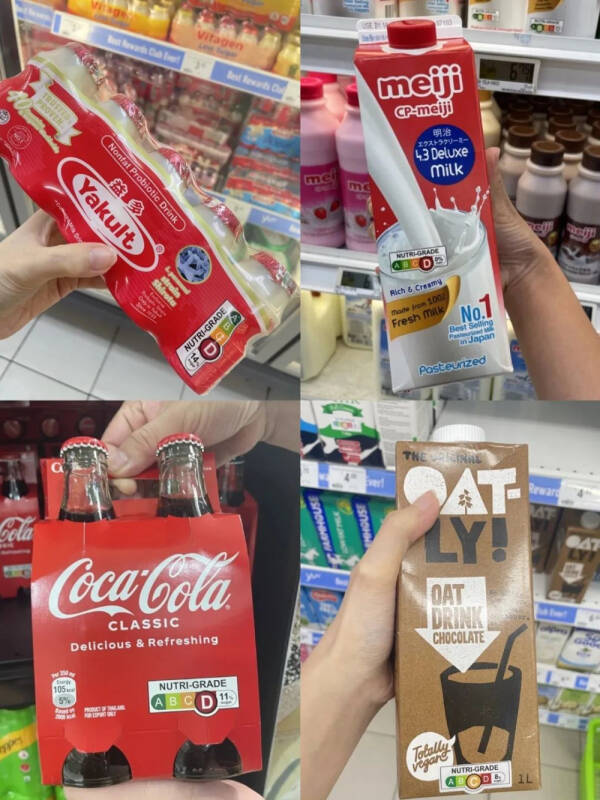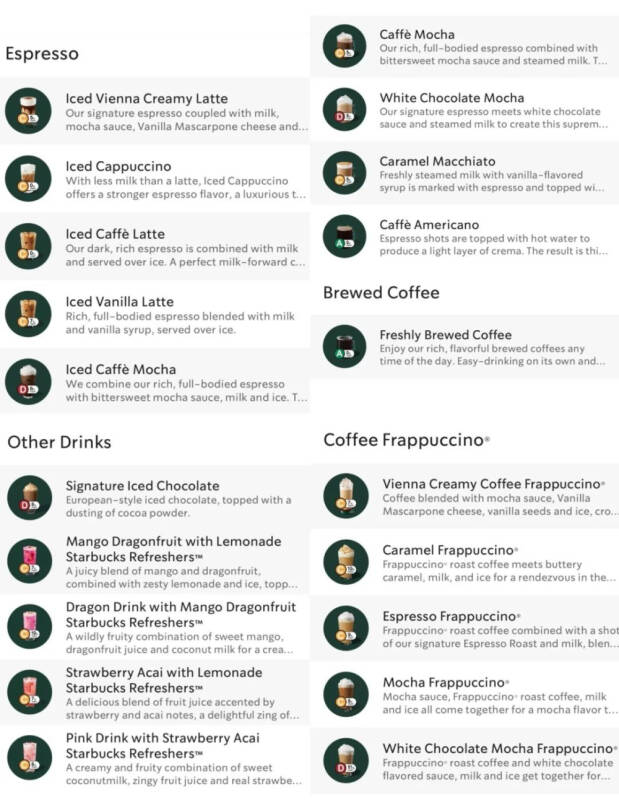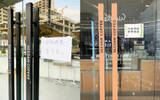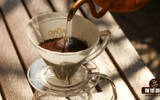At present, the beverage is graded forcefully, and the lucky raw coconut latte is "D".
▲
Click follow | Daily boutique coffee culture magazine coffee workshop
Since December 30 last year, the Singapore government has implemented the Beverage Sugar restriction order, requiring nutrition grade labels (Nutri-Grade) to be printed on packaged beverages, and issued supplementary measures on June 30, expanding its scope of application, becoming the first country in the world to ban the advertising of high-sugar drinks.
Recently, the Singapore government once again updated the regulations, starting from today, requiring all currently mixed drinks must also be labeled with ABCD nutrition level and sugar content. With the implementation of the new policy, almost all drinks available in Singapore will be included in the grading system.

In other words, in addition to pre-packaged drinks, ready-made drinks (freshly brewed coffee, milk tea, Fresh Juice, etc.) should also be labeled, and even the ingredients added in ready-made drinks (pearls, coconut, ice cream, fairy grass) should be marked with sugar content.
According to Singapore Eye Media, many businesses have switched to new paper / electronic menus, such as Singapore's national milk tea brands LiHO, KOI Th é, smoothies Boost, and Nanyang coffee shop chain Yakun, which have put up corresponding "grade signs" for their drinks for consumers to choose from.
The Starbucks Singapore store, which does as the Romans do, also updated a single page on the 27th, adding nutrition level labels to various drinks. Although most of the drinks currently blended are grade C, Starbucks said that consumers can ask baristas to adjust the raw materials and sweetness. For example, caramel macchiato, which originally belongs to grade C, is a grade B drink if it chooses to reduce the sweetness and switch to low-fat milk.

Another netizen found that Ruixing's hot coconut latte was rated Grade D because of its high sugar content and high fat content. The thick latte is also about the same, and is classified into Class C because of its high sugar content.
So, what do you think of this nutrition level? According to the proportion of sugar per 100g and saturated fat per 100g, all drinks are divided into four grades A, B, C and D, which are distinguished by different colors such as dark green, light green, yellow and red, so that consumers can better identify healthy drinks when buying.
Among them, the sugar content and saturated fat content of grade An and B drinks are relatively low, with more than 5 grams of sugar and 1.2 grams of saturated fat in every 100 ml of beverages belong to grade C, and more than 10 grams of sugar and 2.8 grams of saturated fat belong to grade D. In short, Class An is the healthiest, such as sugar-free black coffee, and Grade D is the least healthy, like honey lemonade.
The regulations show that drinks classified as Grade C or D must prominently display grade labels on the front of the packaging, and advertising of Grade D products will be prohibited. For healthier grade An and B drinks, manufacturers can choose whether or not to print grade labels. Merchants who break the rules for the first time will be fined up to S $1000, followed by a maximum fine of S $2000 at a time.
Although in the category of the same type of drinks, it is basically true that the higher the rating, the better the health. But for whole milk, there is also "unfairness". Because ratings simply put sugar content and fat content in the same standard, whole milk with natural lactose / galactose is forced to fall into C or D grades.
The Singapore government enforces this beverage grading system because locals really love sugar, and high sugar intake is associated with an increased risk of obesity and diabetes, but the sweet temptation is hard to resist.
It is understood that the average Singaporean eats 60 grams of sugar per day, half of which comes from sweet drinks, so that the prevalence of diabetes is also very high, about 8%. If no action is taken, about 1 million Singaporeans are expected to have diabetes by 2050. For this reason, the Singaporean government conducted in-depth investigation and research a few years ago and launched the "Beverage Sugar restriction order."
For the sake of the health of the people, the Singaporean government is also heartbroken.
Disclaimer: some of the pictures in this article come from the network, and some of the contents of the website, such as pictures, we will respect the origin of the original copyright, but due to the large number, there will be individual pictures and texts not in time to indicate, please forgive me. If the original author has any disputes can contact the website to deal with, once verified we will immediately correct, by the "coffee workshop" collation and editing, reprint please indicate, if infringement, please inform deletion, thank you ~!
Important Notice :
前街咖啡 FrontStreet Coffee has moved to new addredd:
FrontStreet Coffee Address: 315,Donghua East Road,GuangZhou
Tel:020 38364473
- Prev

Seesaw stores are closed all over the country!
▲ Click to follow | Daily boutique Coffee Culture Magazine Coffee Workshop is entering the end of the year, and the news that several stores of boutique coffee brand Seesaw Coffee ("Seesaw") have been closed across the country has aroused widespread attention and discussion on social platforms. Not long ago, netizens sent messages one after another.
- Next

Why is the steaming time of hand coffee 30 seconds? How to calculate the steaming time? Does stuffy steam count as a section?
Stuffy steaming, called "Bloom" in English, refers to a preparatory action before the formal extraction of coffee by hand. Many experienced coffee lovers have studied the details of water quantity, time, water injection method and so on, and summed up the foggy steaming formula with high fault tolerance and the most widely used: twice the amount of water of coffee powder (15g).
Related
- Is espresso stored overnight in the refrigerator harmful to your body? Is frozen coffee better than freshly ground coffee?
- What parameters and proportions of water temperature should be used to grind and brew fresh coffee beans? Why can't I drink freshly roasted coffee right away?
- Customers have "changed" Manner's new products! Shop assistant: Please don't mess around!
- Remove sockets in customer areas at Starbucks stores?! Netizen: I won't go if I really tear it down
- What is the difference between the taste steps of sun-dried coffee and washed coffee? Why is sun-cured coffee sweeter and washed coffee sour?
- The recipe for salty grapefruit dirty is revealed! Coffee Festival salty grapefruit dirty coffee making materials parameters ratio milk share!
- How about the flavor of Sunlight 74158 at Sidamo Banshaha Mathieu Processing Factory in Ethiopia? 74158 Share the proportion of coffee brewing parameters!
- What effect does Italian American coffee with filter paper have? Will coffee taste better if it is put on filter paper at the bottom of the powder bowl?
- What is the color difference in coffee beans? What are the characteristics of honey processed coffee beans? Why are the anaerobically treated coffee beans uneven in color?
- How does novice Xiaobai quickly get started and make coffee? Newbies learn to make coffee by hand and share the specific steps and process process!

